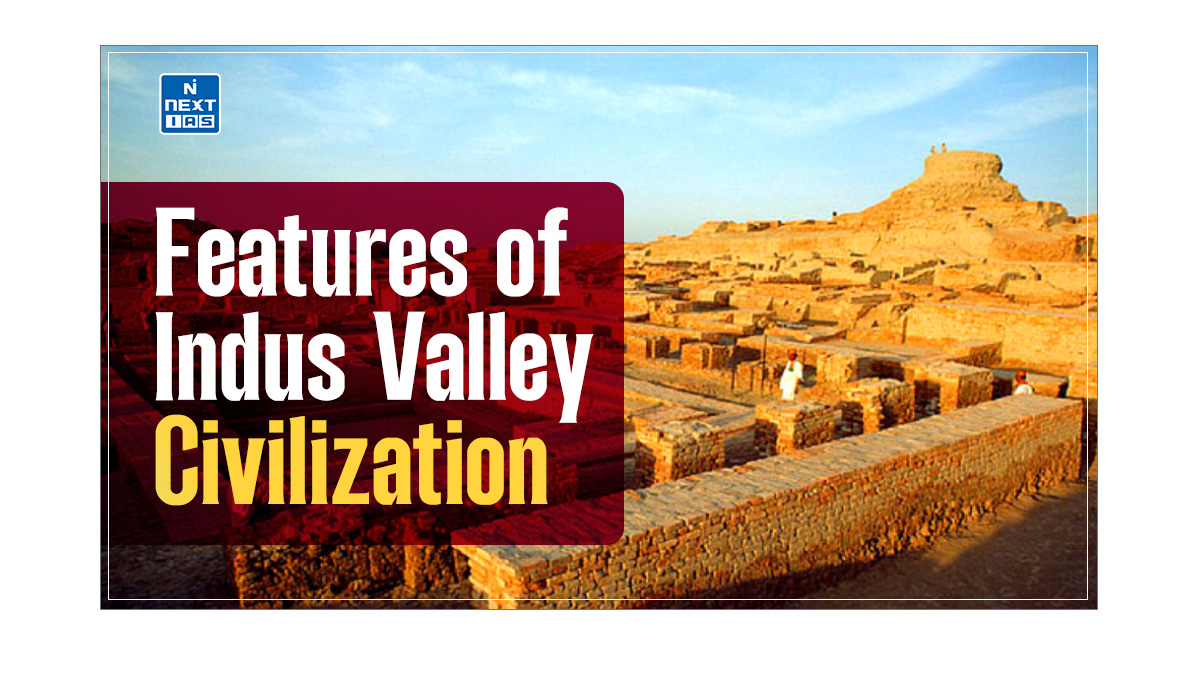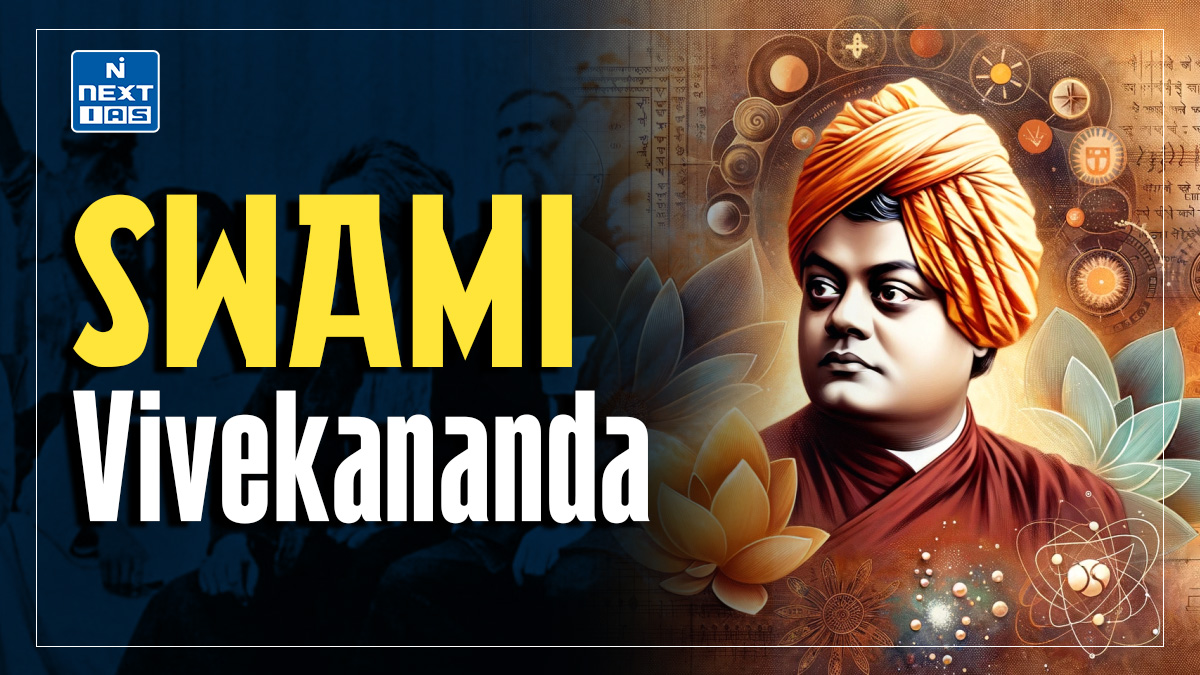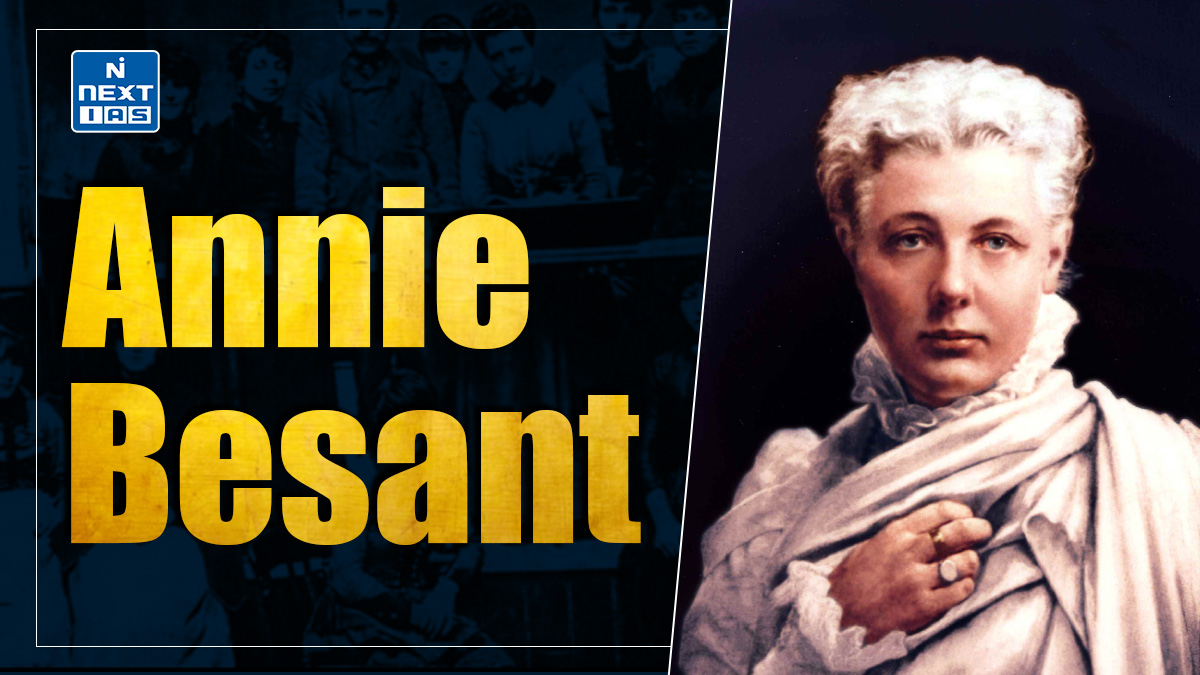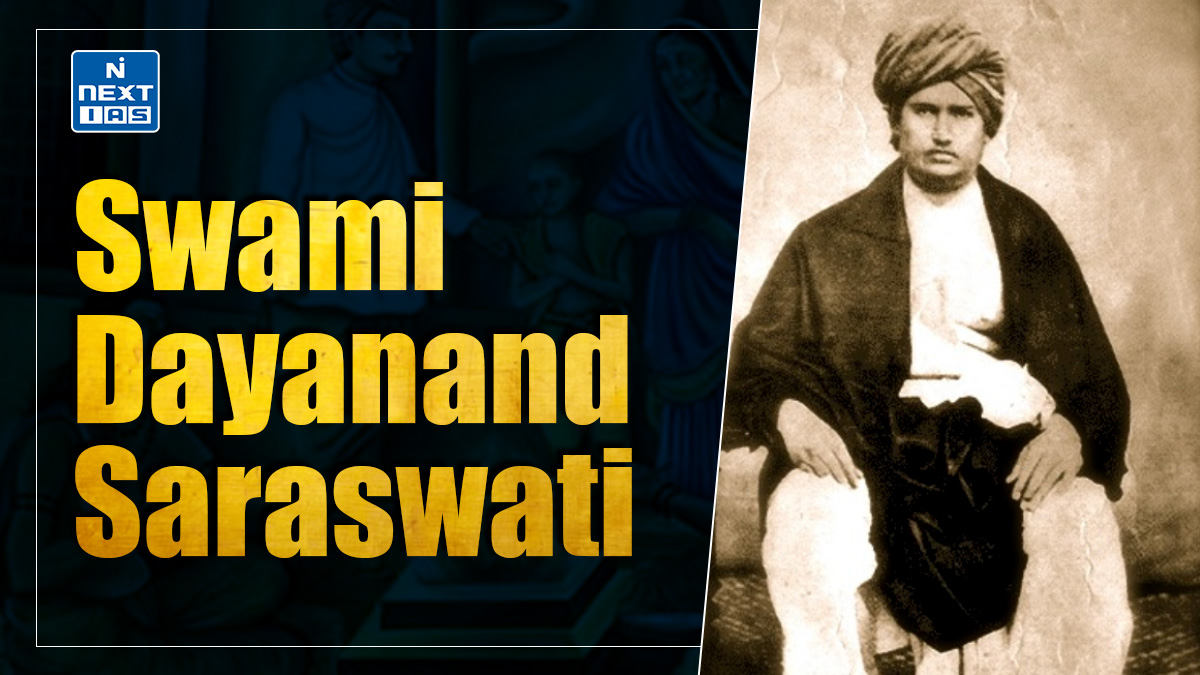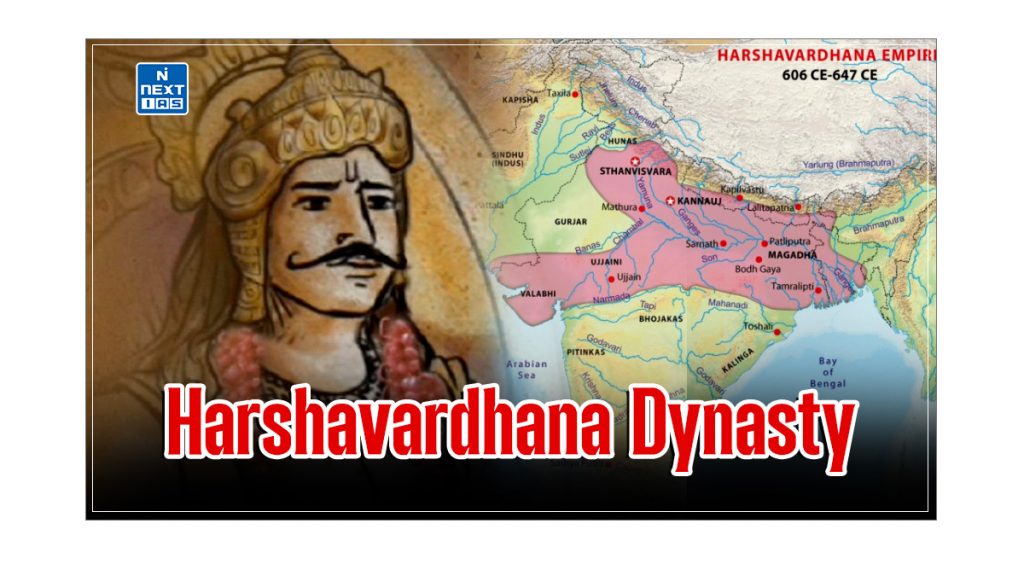
The Harshavardhana Dynasty, also known as the Pushyabhuti Dynasty, ruled northern India during the 6th and 7th centuries AD, with its most notable ruler being King Harshavardhana. The dynasty’s significance lies in Harsha’s efforts to unite much of North India, his patronage of Buddhism, and the cultural advancements during his reign. This article aims to study in detail the political, cultural, and religious aspects of the King Harshavardhana Dynasty, focusing on Harsha’s contributions to Indian history.
About Pushyabhutis Dynasty
- The Pushyabhuti dynasty ruled the northern regions of India in the 6th-7th Century AD.
- King Harshavardhana was the most prominent ruler of the Pushyabhuti dynasty.
- At its zenith under Harsha, the extent of the Pushyabhuti Empire covered much of North and Northwestern India.
- It was extended to the East till Kamarupa and in the South until the Narmada River.
- According to Harshacharita by Banabhatta, the dynasty was founded by Pushyabhuti, a devotee of Lord Shiva.
- Historians assume that, like the Maukharis, their neighbours in the east, the Pushyabhutis took advantage of the fall of the Gupta Empire to assert independence and found a new kingdom and dynasty.
- The seat of the Pushyabhuti Empire was supposed to be at Sthaneshwar (Modern Thanesar).
- The details of the dynasty are available from the reign of Prabhakarvadhana, the fourth ruler.
- He assumed the title of Maharajadhiraja. He feuded with the Huna invaders from North-Western India.
- He had two sons, Rajyavardhana and Harshavardhana, and one daughter, Rajyashri, who was, as discussed earlier, married to Grihavarman of the Maukhari dynasty.
- After the death of Prabhakarvardhana, Rajyavardhana assumed the throne.
- Grihavarman was killed by a later Gupta king of Malwa, who also abducted his wife Rajyashri.
- Resultantly, Rajyavardhana marched against the Malwa king and defeated him.
- But while returning to Thanesar, he was killed by ‘Sasanka’, the Gauda King.
- This resulted in the coronation of King Harshavardhana as the Pushyabhuti King, who turned out to be the most outstanding ruler of India in the 6th-7th century AD.
King Harshavardhana

- King Harshavardhana, the second son of Prabhakara Vardhana, was the most distinguished ruler of the Pushyabhuti dynasty.
- He ruled from his capital, Kannauj, from 606 AD to 647 AD, for 41 years. After the fall of the Gupta Empire, King Harshavardhana was able to bring much of northern India under his control.
- His rule spread over the present states of Punjab, Bengal, and Orissa and covered the entire Indo-Gangetic plain, with the Narmada River marking the southern boundary.
- After his accession, he also united the kingdoms of Thanesar (Modern Kurukshetra Region) and Kannauj.
- Apart from the regions under his direct control, his sphere of influence spread much beyond his empire. It seems that the peripheral states acknowledged his sovereignty.
- In eastern India, he faced opposition from the Shaivite king Shashanka of Gauda, who cut off the Bodhi tree at Bodh Gaya.
- But Shashanka’s death ended this hostility. Pulakeshin-II, who ruled over a greater part of Karnataka and Maharashtra, stopped Harsha’s downward southward journey on the Narmada River.
- His reign is well-documented thanks to his court poet Banabhatta in Harshacharita and by Chinese traveller Xuan Zang (Hieun Tsang).
Buddhism during Harshavardhana’s Rule
- The traditional forms of Buddhism declined during Harsha’s accession to the throne.
- The period witnessed a synthesis between the Vedic and Mahayana sects of Buddhism.
- Idol worship of Lord Buddha was still prevalent in many parts of the kingdom.
- Later, after the arrival of Buddhist Monk Hieun Tsang, Harsha became a devout follower of the Mahayana sect of Buddhism.
- His two assemblies in Kannauj and Prayag were showcases for promoting Buddhism in his kingdom.
- He erected thousands of stupas and established travellers’ rests all over his kingdom for Buddhist monks.
Harshavardhana’s Assemblies
Harsha held two memorable assemblies in Kannauj and Prayag during the time of Hiuen Tsang.
Kannauj Assembly
- In 643 A.D., Harsha held a great religious assembly in his capital, Kannauj.
- The primary purpose of convening the assembly was to highlight the teachings of Buddha, notably Mahayana Buddhism.
- Harsha also wanted to use the occasion to honour Hiuen Tsang, and he was made to preside over the assembly.
- All the tributary kings and scholars of Nalanda attended the council, which lasted 23 days.
- The most critical construction was a massive tower in the middle of which a golden statue of the Buddha was placed; this statue was as tall as the king himself.
Prayag Assembly
- Another spectacular assembly at Prayaga in the same year followed the Kannauj Assembly.
- It was known as the Maha Moksha Parishud. Harsha held this assembly every five years to donate gifts to people.
- The assembly that Hiuen Tsang saw at Prayaga in 643 A.D. was the sixth such Moksha Parishad held in Harsha’s reign.
- While the Kannauj Assembly was primarily religious in nature to highlight the Mahayana sect of Buddhism, the Prayaga Assembly was known for offering charities to all classes of people.
- It saw a huge gathering of people. Emperor Harsha and Hiuen Tsang attended this unique assembly and distributed gifts among the people.
- The assembly’s ceremonies lasted 75 days. Every arrangement was detailed for accommodation and food for such a big gathering.
- During this assembly, Harsha installed three images of Buddha, Sun, and Shiva and gave away everything he had except his clothing.
Conquest of Harshavardhana
- Harshavardhana, the last great Hindu emperor of North India, consolidated a vast empire through a series of strategic conquests.
- He began by defeating Sasanka, the ruler of Bengal, and annexed his territory.
- Harsha then expanded his dominion southward, conquering regions like Kannauj, Ahichatra, and Shravasti.
- His empire stretched from the Himalayas to the Narmada River and from the Punjab to the eastern coast.
- However, his ambitions were met with resistance from the Chalukya king Pulakesin II, who defeated Harsha on the banks of the Narmada.
- Despite this setback, Harsha continued to rule over a significant portion of North India, leaving a lasting impact on the region.
Polity of Harshavardhana Dynasty
- After the fall of the Gupta Empire, North India witnessed the creation of small republics and small monarchical states ruled by remnants of Gupta rulers.
- Harsha united the small republics from Punjab to central India to form his empire.
- The Harshavardhana Empire consisted of two different types of territories:
- First, the areas directly under Harshavardhana’s rule, such as Rajputana, Central Provinces, Gujarat, Bengal, and Kalinga, and
- Second, states and kingdoms such as Sind, Jalandhar, Kashmir, Nepal, and Kamarupa (modern-day Assam) became feudatories under him.
- Harsha maintained alliances with the King of Assam and the ruler of Vallabhi Dhruvasena. He also maintained diplomatic relations with the Chinese empire ruled by Tai Tsung of the Tang Dynasty.
Administration of Harshavardhana Dynasty
- The administration of the Gupta Empire largely inspired the administrative system of Harshavardhana.
- The King was the all-powerful head of administration, vested with supreme legislative, executive, and judicial powers.
- However, despite being based on a strict monarchial pattern, the administration of Harsha was far from autocratic.
- The king maintained moderation and rested on popular support for discharging the duties of the kingdom.
- The kingdom was divided into various provinces or divisions called Bhukti.
- These were further divided into Visayas, which corresponded to modern districts.
- Pathaka was a still smaller territorial term, perhaps the size of the present-day taluk. The lowest unit of administration was Grama.

- The records also show that Harsha believed in self-government in the village communities.
- All the powers were not concentrated in the hands of the central government.
- Local and regional bodies were given much autonomy in conducting the affairs of the state.
- The Council of Ministers worked effectively during Harshavardhana’s time. It made important decisions in times of crisis and was headed by a chief minister.
- King Harshavardhana also indulged in various personal inspection tours to obtain a firsthand account of governmental works in urban and rural areas.
- Through his royal march throughout the country, he acquired a ground knowledge of the people’s conditions.
- Land grants continued to be made to priests for special services rendered to the state.
- In addition, the charters credit Harsha with granting land to officers.
- Ministers and high state officers were endowed with land. The feudal practice of rewarding and paying officers with land grants seems to have begun under Harsha, which explains why only a few coins were issued during his rule.
- The Chinese pilgrim Huan Tsang informs that Harshavardhana’s revenue was divided into four parts.
- One part was earmarked for the King’s expenditures, a second for scholars, a third for the endowment of officials and public servants, and a fourth for religious purposes.
- In the empire of Harsha, law and order were not in place. However, the guilty, when caught, were severely punished by amputation or death.
- However, the influence of Buddhism mitigated the severity of punishment, and criminals were imprisoned for life.
- Harsha had a well-organized standing army. It had elephants, camels, cavalry, and infantry.
- Cavalry and elephants had separate commanders. The head of the cavalry was called Brihadasvavaru.
- The king was assisted by a council of ministers known as Mantri-Parishad, who advised him on all important affairs.
- Harshacharitha by Banabhatta gives us a list of ministers. Kumaramatyas, or Cabinet Ministers, manned the superior civil service.
Religion of Harshavardhana Dynasty
- The founders of the Pushyabhuti dynasty were Shaivites, and thus, Shaivism was the primary religion under Harshavardhana’s reign.
- Harshavardhan’s period coincided with the rapid rise in the influence of the Vedic religion, and Buddhism was slowly and gradually declining.
- During Harshavardhana’s era, Brahmanism was divided into various schools of philosophy and orders.
- Sankhya’s philosophy was rapidly progressing and attracted a large number of followers. Performing various rites and rituals was considered a sacred duty.
- A lot of importance was attached to charity, which is evident because, after every five years, Harsha donated all his wealth.
- Harsha was a devotee of Shiva, Surya, and Buddha. He and his sister were drawn to Buddhism thanks to Hiuen Tsang, who, in his discourse, explained the importance of Mahayana Buddhism to them.
- Harshavardhana’s enthusiasm for his new faith led him immediately to organise the grand assembly at Kannauj to give publicity to Huien Tsang’s masterly treatise on Mahayana and establish its supremacy.
Literature of Harshavardhana Dynasty
- Banabhatta’s book Harshacharita, in an ornate style, flatteringly accounts for his patron’s early years and became a model for later writers.
- Harsha is not only known for his patronage and learning but also for writing three dramas:
- the Priyadarshika,
- the Ratnavali, and
- the Nagananda.
- Banabhatta attributes great poetic skills to him, but some later authors consider him a literary monarch.
- It is held that they were composed by Dhavaka in Harshavardhana’s name for some consideration.
- Harshavardhana might have composed some pieces, but the proverb goes that royal authors are only half authors.
- In Ancient and Medieval India, all literary achievements were attributed to the King to boost his image.
- This practice started during the time of Samudragupta and became well-established during the rule of Harsha.
Economy of Harshavardhana Dynasty
- General trade and commerce seemed to decline during Harshavardhana’s period.
- This is evident from the decline of erstwhile trade centres, the availability of fewer coins from that period, and the disintegration of merchant guilds.
- This decline in trade adversely affected the Agriculture and handicrafts industry.
- Since the demand for goods declined, the farmers began to produce in a limited way for self-consumption.
- This resulted in the rise of a self-sufficient village economy.
- Thus, the Harsha period experienced a sharp economic decline compared to the Gupta period.
Society of Harshavardhana Dynasty
- Scholars like Banbhatta and Hieun-Tsang account for the social conditions prevailing during Harshavardhana’s rule.
- The society had a four-fold Varna division, with Brahmanas being the most privileged among them.
- King frequently presented land grants to Brahmans. The other two significant varnas were Kshatriya – the warrior class, and Vaishya- the trading class.
- The fourth varna – Kshudras, were largely involved in Peasantry during Harsha’s reign.
- Untouchability was practised against scavengers, executioners, etc. The untouchables lived outside the villages and took garlic and onion.
- They announced their entry into the town by shouting loudly so that people might keep away from them.
- The status of women in society was relatively good. The purdah system was non-existent, and women from noble families received an education.
- The institution of marriage was strict, and inter-caste marriages were not permitted.
- Even Marriages within the same caste were prohibited to certain degrees.
- However, still there were many ill-practices and biases against women:
- The ill-practice of Sati was Prevalent.
- Remarriages of widows were not permitted, particularly in the Higher castes.
- The dowry system has taken deep roots.
- The system of Swayamvara was declining, and women were not allowed to choose their husbands.
Importance of Harshavardhana Dynasty
Some of the distinguishing features of the Harshavardhana Dynasty are:
- The Harshavardhana Dynasty saw the rise of one of the greatest native Hindu kingdoms of the subcontinent. They were succeeded by the Mamluk slave dynasty and then the Mughal dynasty.
- Though Hinduism was a major religion, the kings of this phase were largely tolerant of all religions. Under the reign of Harsha, Buddhism flourished. Rashtrakuta kings were great patrons of Jainism.
- The Harshavardhana Dynasty is renowned for creating marvellous architecture, the pinnacle of Indian cultural legacy.
- Only in this phase were the rock-cut caves of Ajanta/Ellora and the temple architecture of Odisha created.
- The Harshavardhana Dynasty is also known for its rich development in literature and language. Great Kings like Harsha were themselves accomplished poets.
- Regional languages like Kannada flourished in this phase, and the dominance of Sanskrit and Prakrit was controlled.
- Harshavardhana Dynasty also saw the development of education centres like Nalanda and the construction of Viharas in Vikramshila, Odantapuri, Somapuri etc.
Limitations of Harshavardhana Dynasty
The Harshavardhana Dynasty coincided with the decline of the Guptas. The dynasties and kingdoms of these phases were relatively small, less stable and more involved in conflicts with each other, resulting in a lack of focus on administration. Some limitations of this phase are:
- The Harshavardhana Dynasty witnessed the rise of several kingdoms in relatively lesser time, thus displaying a lack of political stability.
- According to Hiuen Tsang’s account, economic prosperity and the law and order scenario declined relative to each other.
- Very few coins of this phase are available, again showing economic hardships.
- The caste and varna system took deep roots in this phase.
- The evil practices of dowry and Sati against women were also present in this phase.
- The monarchial system of government puts too much power in the hands of the king. When a dynasty witnessed a weak king, it declined rapidly.
Conclusion
The Pushyabhuti dynasty, especially under King Harshavardhana’s reign, made a profound impact on Indian history. Harsha’s leadership not only brought stability and expansion to North India but also fostered a period of religious tolerance and cultural growth. Despite limitations like economic decline and internal strife, this phase witnessed the flourishing of literature, Buddhism, and the construction of architectural marvels. The dynasty’s legacy is etched in India’s historical narrative as a period of significant transition and cultural evolution, with King Harshavardhana remaining a key figure in early medieval Indian history.
Frequently Asked Questions (FAQs)
Who was Harshavardhana?
King Harshavardhana was the last great Hindu emperor of North India.
Who wrote the biography of Harshavardhana?
Banabhatta wrote the biography of King Harshavardhana, titled Harshacharita.
Who defeated Harshavardhana?
King Harshavardhana was defeated by the Chalukya king Pulakeshin II in the Battle of Narmada.
Who was the court poet of Harshavardhana?
The court poet of King Harshavardhana was Banabhatta.

